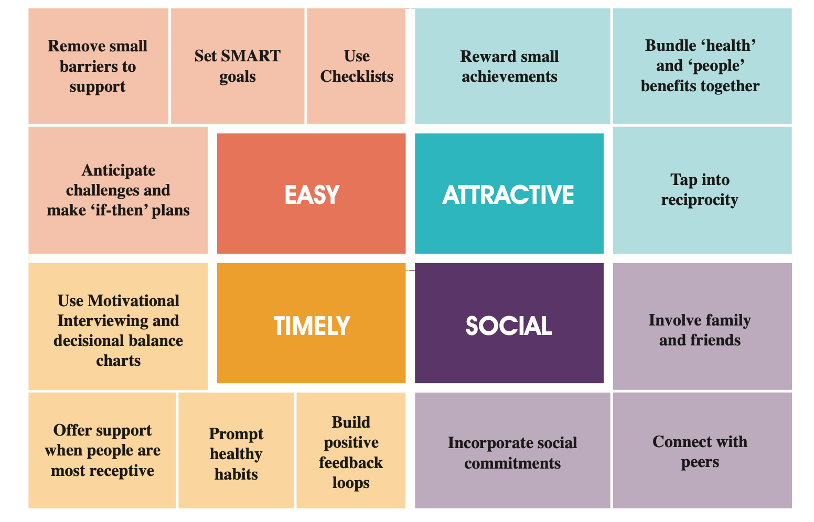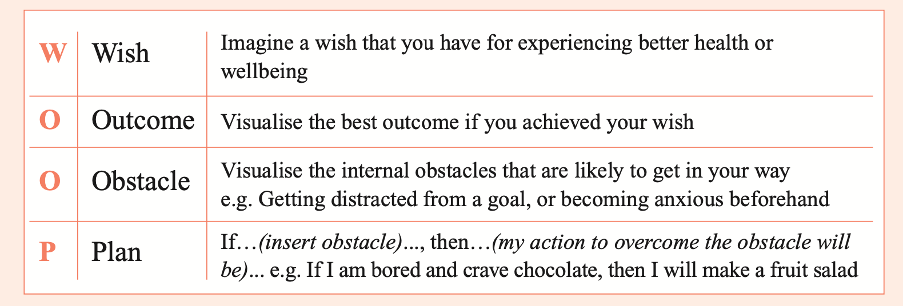EAST-ern medicine — how behavioural science can help people self-manage their health and wellbeing
A user-friendly guide about what drives our behaviour can help people living with long-term conditions and those who support them get started (and stay) on a journey of self-management. It can also help prevent long-term conditions from developing in the first place.
A simple framework to support self-management
The guide offers a simple framework created by the Behavioural Insights Team in the UK that uses science to change people's behaviour. It's called EAST — which stands for Easy, Attractive, Social and Timely.
It also suggests tools you can use to support people to make their desired changes.
If you want people to do something, make it easy for them. Make it look good, too. People are influenced by others, so make it social. And timing is important.
It looks like this:

Make it EASY
Reduce the ‘hassle factor’
The hassle or ‘friction’ people experience on the way to getting the support they want can mean that people don’t manage to get started in the first place.
Examples of the small barriers that can get in the way could be:
- needing a referral to a service
- not knowing how to get to the service
- having to fill out forms or do something else before receiving support
- not making a plan to access support the day it’s needed.
Providers can help reduce these barriers. For example, they can:
- allow people to self-refer with as few eligibility criteria as possible
- offer telephone or video link support sessions if people find it difficult to travel
- send text messages to remind people of their next appointment
Break activities into small steps
Changing behaviours to prevent or manage long-term conditions can be overwhelming, especially when there are many different things to do. For example, someone may need to attend appointments, lose weight, exercise more, eat differently and start taking medication.
It can be helpful to break things down into small steps. For example, reducing fat intake could involve finding new recipes, shopping for different ingredients or eating out less. Focusing on small steps makes it easier to build healthy habits.
Set SMART goals
Health coaches and others can help people to identify manageable ‘chunks’ by setting goals that are (S)pecific, (M)easurable, (A)greed by the person, R(ralistic) and (T)ime-bound):
This involves taking vague goals (‘I want to get fit’) and translating them into specific and achievable actions (‘I’ll take the stairs instead of the elevator on Tuesday and Wednesday’, ‘I’ll phone and make an appointment at the gym on Monday 14 March’).
Using checklists
Using simple checklists with self-management behaviours is an effective way to break down complex tasks into easier-to-manage steps.
Anticipating challenges and making ‘if-then’ plans
People can achieve lasting behaviour change by making a plan that identifies the obstacles that they might face when trying to change habits, and then making a simple but specific ‘if-then’ plan to overcome these obstacles.

People can use the WOOP tool to do this.
Make it ATTRACTIVE
Reward small achievements
Self-management can be made more appealing by rewarding small achievements and focusing on immediate gains rather than long-term ones.
People can plan for treats and rewards each time they manage to change an unhealthy to a healthier one. For example, instead of giving up sweet foods completely, they can learn how to make healthy treats to snack on in between healthy meals.
Intrinsic motivation and the fun factor
People are more likely to stick to new behaviours in the long term if they are intrinsically motivated to do so and find them fun.
In a study, researchers found that making ‘fun’ activities (like listening to audiobooks) only available while doing a less enjoyable activity (going to the gym) can increase the likelihood of sticking to the less enjoyable activity.
Use freebies to tap into reciprocity
Freebies can be a good way to get people's attention and encourage them to try new things.
For example, offering free tea and biscuits at a technology session for older people can encourage them to learn new skills and engage in conversations about self-management.
Make it SOCIAL
Humans are social beings. We are heavily swayed by what those around us do and say. We can use this to help people self-manage.
Involve family and friends
Involving family and friends in the change we want to make can increase our chances of success.
For example, people who attended a course with a supporting partner were more able to make self-management and lifestyle changes because they didn’t need to go home to explain the content to their supporters.
The impact of involving family and friends can be seen in this video.
Connect with peers
Connecting with peers who have similar experiences, can be role models and provide support and practical advice can be a great way to improve self-management behaviours.
It can also help people feel less isolated, which can be a problem for those dealing with long-term conditions.
Incorporate social commitments
Studies have shown that making a social commitment to a goal (like signing a ‘contract’ with people in your walking group to walk together twice a week) can help people stay more committed to a task.
This tool can help people do this.
Make it TIMELY
Offer support when people are ready to receive it
People respond differently to prompts, messages or offers of support depending on when they receive them. For long-term health conditions, people go through different stages of motivation for behaviour change.
They often aren’t ready for change when they visit healthcare practitioners. No wonder practitioners often struggle to encourage patients to make changes for better health and well-being. Simply giving advice or information is unlikely to work.
They can use the readiness for change model and motivational interviewing to help people identify personal solutions to their problems once they are ready for change.
A tool called the decisional balance matrix can help.
Prompts
It can be difficult to remember to do things differently, even if we want to. One way to overcome this is to support people to embed prompts into their existing routines.
For example, they can use the reminder functions on their personal devices. Or services can send text message reminders to people to help them remember their appointments.
With the power of behavioural science on your side, you can help people you work with overcome the challenges of managing their long-term condition and thrive in all aspects of their lives.

